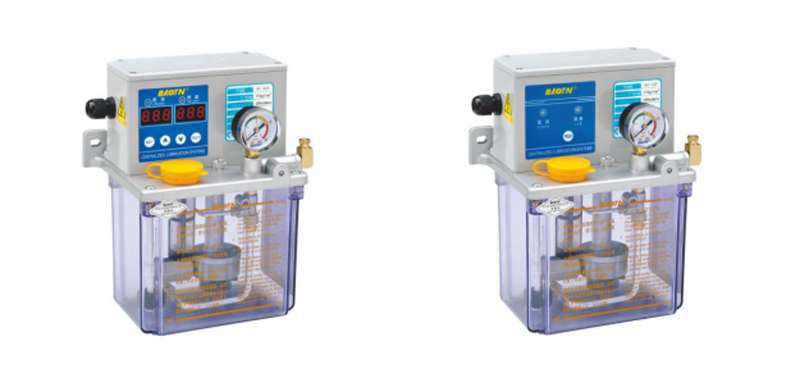
Lubrication pumps, also known as grease pumps, are critical components in industrial machinery. They deliver precise amounts of lubricant to mechanical components, minimizing friction, reducing wear, and extending equipment lifespan. Below are their defining characteristics:
Integration with Machine PLC Systems
Designed for compatibility with CNC machine PLCs, eliminating the need for a standalone controller.
Digital Display or Programmable Logic Control (PLC):
Adjustable oil pump operation cycles (1–999 seconds) and rest intervals (1–999 minutes) for tailored lubrication schedules. Real-time monitoring of lubrication parameters enhances operational efficiency.
Low Oil Level Alert System: Equipped with float-type or sensor-based (liquid level switches) to trigger warnings when lubricant reserves are insufficient.
Pressure Relief Valve: Prevents system overload by diverting excess pressure, safeguarding pump integrity during sudden pressure spikes.
Lubrication Objectives & Critical Maintenance Guidelines
1. Purpose of Centralized Lubrication Systems
Friction Reduction & Wear Prevention: Rapid sliding motions between machine surfaces (e.g., guideways, ball screws) require a consistent oil film to separate components and minimize metal-on-metal contact.
Corrosion & Contaminant Protection: Lubricants form a protective barrier against moisture, acidic residues, and airborne pollutants, preventing oxidation and chemical degradation.
2. Lubricant Selection
Avoiding "Recycled Oil".
Recycled oils contain abrasive particles and contaminants that clog oil lines, damage pump internals, and starve lubrication points.
Hazardous Components in Recycled Oils: Water, acids, alkalis, and formaldehyde accelerate corrosion in pipelines, bearings, and seals.
Water-oil emulsions oxidize at high temperatures, forming sludge and vapor pockets that rupture protective oil films.
Volume Efficiency: Most components require minimal lubrication (e.g., 0.01–0.05 mL/hour for rolling bearings).
Using recycled oil is unnecessary and counterproductive—akin to using contaminated fuel in automotive engines.
Viscosity Requirements for Optimal Performance
Role of Viscosity in Lubrication: Properly viscous oils maintain a stable film thickness under operational loads and temperatures. Low-viscosity oils fail to separate surfaces; high-viscosity oils increase energy consumption and heat generation.
Always use oils matching the manufacturer’s specified viscosity range (e.g., ISO VG 32/46/68).
Risks of Oil Substitution & Mixing
Avoiding "Alternative" or "Mixed" Oils:
Incompatible additives or base oils can react chemically, causing gelation, sedimentation, or loss of lubricity. Case studies show improper oil mixing leads to erratic lubrication, accelerated wear, and catastrophic machine failure.
Sealed Oil Path Requirements:
Maintain oil lines at ~12 kgf/cm² pressure to ensure proper flow through distributors.
Nylon Hose Precautions:
Use spring guards to protect against abrasion and kinking in high-vibration environments.
3. Operational Best Practices for Lubrication Pumps
Startup Protocol for New Systems
Priming the Oil Path: Activate the manual button repeatedly during initial use to purge air bubbles and ensure full oil circulation.
Recommended Timing Settings: Dispensing Phase: 30 seconds (ensures adequate oil delivery).
Rest Interval: 25 minutes (balances lubrication needs with energy efficiency).
Routine Inspection Checklist
Monitor oil levels weekly and refill before triggering low-level alerts.
Inspect hoses and connectors monthly for leaks, cracks, or wear.
Test pressure relief valves annually to confirm proper functionality.
Troubleshooting Common Issues
Clogged Distributors: Flush lines with manufacturer-approved solvents.
Erratic Pump Cycling: Recalibrate PLC timers or replace faulty sensors.
There are many Famous Lubrication Pumps series, such as Schneider Electric: Telemecanique Lubrication Pumps, Bosch Rexroth: LDM Series Grease Pumps, Lincoln Industrial: Single-Point Lubricators. We will talk about the brands and sereis lubrication pumps in the next article.
Lubrication pumps (oil dispensing systems, automatic greasers) are indispensable for sustaining machinery health. Adhering to viscosity standards, avoiding recycled oils, and maintaining sealed systems ensure uninterrupted operation. By integrating these practices, facilities reduce downtime, lower repair costs, and maximize ROI on capital equipment.
Tel:+86-51268235075
Fax :+86-51268235075
Mobile:+86-13390848665
E-mail: cncsale@ricocnc.com
Skype: ccsalce
Whatsapp: +86-13390848665


